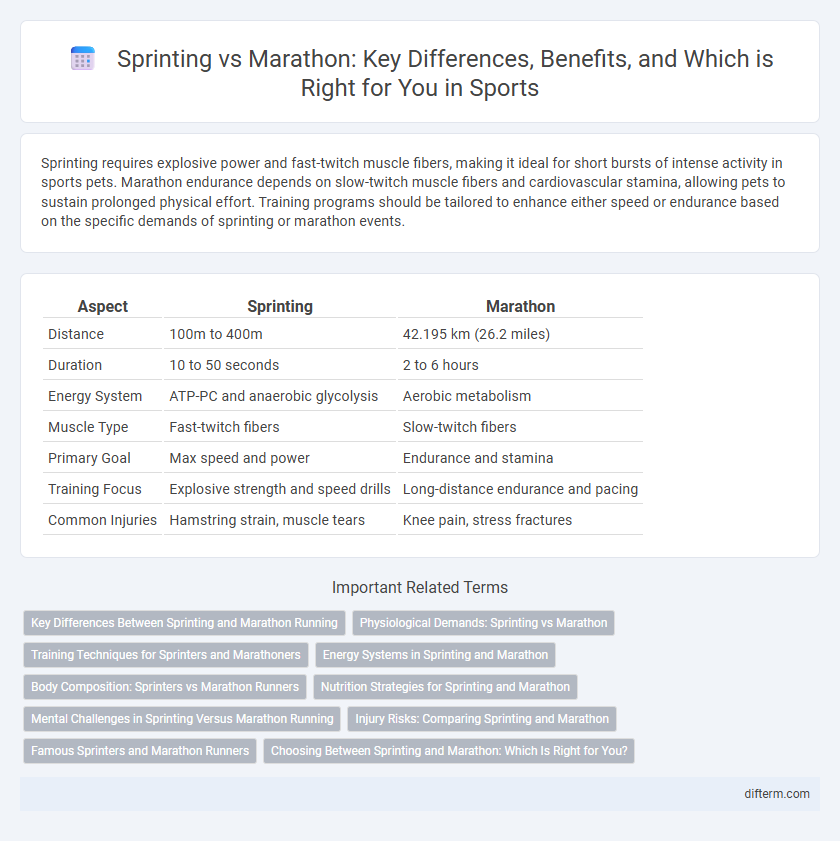Sprinting requires explosive power and fast-twitch muscle fibers, making it ideal for short bursts of intense activity in sports pets. Marathon endurance depends on slow-twitch muscle fibers and cardiovascular stamina, allowing pets to sustain prolonged physical effort. Training programs should be tailored to enhance either speed or endurance based on the specific demands of sprinting or marathon events.
Table of Comparison
| Aspect | Sprinting | Marathon |
|---|---|---|
| Distance | 100m to 400m | 42.195 km (26.2 miles) |
| Duration | 10 to 50 seconds | 2 to 6 hours |
| Energy System | ATP-PC and anaerobic glycolysis | Aerobic metabolism |
| Muscle Type | Fast-twitch fibers | Slow-twitch fibers |
| Primary Goal | Max speed and power | Endurance and stamina |
| Training Focus | Explosive strength and speed drills | Long-distance endurance and pacing |
| Common Injuries | Hamstring strain, muscle tears | Knee pain, stress fractures |
Key Differences Between Sprinting and Marathon Running
Sprinting involves short-distance, high-intensity bursts of speed typically ranging from 100 to 400 meters, relying heavily on anaerobic energy systems and fast-twitch muscle fibers. Marathon running covers 42.195 kilometers (26.2 miles), emphasizing endurance, aerobic metabolism, and efficient energy utilization over extended periods. Key differences include training methods, muscle fiber recruitment, and physiological demands, with sprinters focusing on explosive power and marathoners prioritizing stamina and cardiovascular efficiency.
Physiological Demands: Sprinting vs Marathon
Sprinting demands explosive power and anaerobic capacity, relying heavily on fast-twitch muscle fibers for short, intense bursts of speed, while marathons require sustained aerobic endurance and slow-twitch muscle fibers for prolonged energy production. Sprinting generates rapid lactic acid accumulation, leading to quick muscle fatigue, whereas marathon running emphasizes efficient oxygen utilization and glycogen sparing to delay exhaustion. Differences in cardiovascular adaptations include higher maximal oxygen uptake (VO2 max) in marathoners and greater muscle phosphocreatine stores in sprinters.
Training Techniques for Sprinters and Marathoners
Sprinters prioritize explosive power and fast-twitch muscle development through high-intensity interval training, plyometrics, and resistance exercises to enhance speed and acceleration. Marathoners focus on endurance by incorporating long-distance runs, tempo runs, and steady-state aerobic training to increase cardiovascular efficiency and muscle stamina. Both disciplines require specialized nutrition plans and recovery protocols tailored to their unique energy demands and muscle fiber engagement.
Energy Systems in Sprinting and Marathon
Sprinting primarily relies on the ATP-PCr and anaerobic glycolysis energy systems to generate rapid bursts of energy over short distances, typically under 30 seconds, facilitating explosive speed and power. Marathon running predominantly utilizes the aerobic energy system, efficiently metabolizing carbohydrates and fats to sustain prolonged endurance efforts over 42.195 kilometers. The distinct energy system demands highlight the physiological adaptations required for sprinting's high-intensity, short-duration output versus marathon's sustained, steady-state energy production.
Body Composition: Sprinters vs Marathon Runners
Sprinters typically exhibit a higher proportion of fast-twitch muscle fibers, resulting in greater muscle mass and lower body fat percentage, which enhances explosive power and speed. Marathon runners possess a leaner body composition with more slow-twitch muscle fibers, optimizing endurance and energy efficiency over prolonged distances. These distinct physiological adaptations reflect the specific metabolic demands and performance goals of sprinting versus marathon running.
Nutrition Strategies for Sprinting and Marathon
Sprinting nutrition emphasizes quick energy sources such as simple carbohydrates and moderate protein intake to support explosive power and short bursts of intense activity. Marathon runners prioritize sustained energy through complex carbohydrates, steady hydration, and electrolyte balance to maintain endurance over prolonged periods. Both athletes benefit from tailored timing of nutrient intake to optimize performance and recovery.
Mental Challenges in Sprinting Versus Marathon Running
Sprinting demands intense mental focus and explosive concentration for short bursts, requiring athletes to maintain maximum effort while managing adrenaline and nerves. Marathon running challenges endurance athletes with sustained mental resilience, strategic pacing, and overcoming fatigue over long distances. Both sports require distinct psychological strengths: sprinters thrive on immediate mental sharpness, while marathoners rely on perseverance and mental stamina.
Injury Risks: Comparing Sprinting and Marathon
Sprinting injury risks primarily involve muscle strains, hamstring tears, and joint stress due to explosive, high-intensity movements, whereas marathon runners face overuse injuries such as stress fractures, tendinitis, and chronic knee pain from prolonged repetitive motion. Sprinting demands maximum anaerobic effort, increasing acute injury potential in fast-twitch muscle fibers, while marathon running's aerobic endurance challenges lead to cumulative microtrauma in ligaments and bones. Proper training techniques, recovery protocols, and injury prevention strategies differ significantly between sprinters and marathoners to address their unique biomechanical stresses.
Famous Sprinters and Marathon Runners
Usain Bolt, known as the fastest sprinter in history, revolutionized 100m and 200m events with multiple Olympic gold medals and world records. Eliud Kipchoge, considered the greatest marathon runner, holds the official marathon world record with a time of 2:01:09 and famously completed a sub-two-hour marathon in a special event. Both athletes exemplify peak performance in their respective domains, highlighting the distinct physical and strategic demands of sprinting versus marathon running.
Choosing Between Sprinting and Marathon: Which Is Right for You?
Choosing between sprinting and marathon running depends on your fitness goals, physical capabilities, and training preferences. Sprinting prioritizes explosive power, fast-twitch muscle fibers, and short-burst anaerobic energy systems, ideal for those seeking quick, high-intensity workouts. Marathon running demands endurance, slow-twitch muscle resilience, and aerobic capacity, suitable for athletes focused on long-distance stamina and consistent pacing.
sprinting vs marathon Infographic

 difterm.com
difterm.com